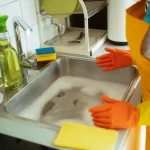Installing a backwater valve will prevent overflowing sewers backing up and flooding your home.
Backwater valves are a popular item lately given the recent heavy rainfall and resulting destruction caused by extensive basement flooding. Often times people aren’t quite sure what to call them, a few names we’ve heard include “sewer check valve” and “backflow valve” when attempting to describe this valve. Regardless, we all should be aware of the important role that backwater valves play, to prevent sewage backup from causing extensive, and costly, basement floods. Nevertheless, when it comes to these important devices, there are many questions we hear time and time again. In today’s post, we’ll look to a couple of those questions in an effort to shed some light on these questions for those who find themselves attempting to gain further insight into the matter.
Backwater Valves Stop Flooding
Sewer backflow is a problem in the City of Toronto; we experience very heavy rainfall during the summer months which can cause the municipal sewer system to backup through the sewer drains of homes and property. The result is a flooded basement; luckily the City of Toronto (and some neighboring cities) provides flood prevention rebates of up to $3,200 to aid in the cost of installing devices including a backwater valve Toronto residents can depend on.
The most effective method to prevent sewer backflow is a simple device called a backwater valve. Installation of this valve prevents water from travelling back into your home as it is a one-way valve. It is bylaw now that modern homes are built with this valve installed, but the majority of older homes are still at risk of basement flooding via sewer backflow which can be a very costly and traumatic experience.
In particularly bad weather it is not uncommon for water damage to be in excess of $25,000+ – protecting your home is always a good idea when compared with the potential cost, loss of personal property, and inconvenience of basement flooding.
Does my Toronto home need a backwater valve installation service?
Depending on how flood-prone your home is you may know already whether or not you require a backwater valve. When required, a backwater valve will be the difference between a flooded basement filled with sewage and a clean and dry basement.
One simple way to tell whether you require a backwater valve installation is to consider your location to the nearby sewer system that services your home and surrounding properties. Imagine there is a street on a gradual hill, there are three homes on this street and the sanitary sewer drain is located at the top of the hill. If the homes further down the hill are below the top of the sanitary sewer then there is a good chance that the sewer will backflow into those homes.
Under these circumstances, a valve will need to be installed to ensure that these basements do not flood. Additionally, there are circumstances where there does not appear to be any specific cause for concern, but when it rains the sewer system backs up and into people’s homes. In these situations, the installation of a backwater valve will also be helpful. You can read more about when you need a backwater valve installed here:
3 SIGNS YOUR HOME NEEDS A BACKWATER VALVE INSTALLATION
If you are experiencing basement flooding but are unsure of the specific cause, we provide additional basement waterproofing services.
Can you help me to claim my City of Toronto backwater valve rebate?
Yes. Our Toronto plumbing services including providing you with assistance to claim your City of Toronto flood prevention rebate. We have installed many backwater valves in Toronto and fully document the process to help you expedite your flood prevention rebate claim.
How does a backwater valve work?
Developed by a plumbing contractor in the City of Edmonton, the mainline backwater valve was an innovation in sewer backup protection. Typically, plumbers would need to install check valves on all of the sewer branch lines in the home. This meant that the kitchen drain, the bathroom drain, the laundry drains all needed to have their own backflow protection. The biggest problem that was noted with each line having its own check valve was that these valves were all over the place, behind walls, under floors, out of sight and hard to access. Not only was that an annoyance to maintain these valves but during drain cleaning services the check valve could easily be damaged by the drain snake. Further, it would be very hard to tell if the check valve had been damaged, it would only be obvious when made evident by a flooding problem.
The mainline backwater valve was the perfect solution; this valve installs directly on the main sewer drain of the property and virtually eliminates the need for multiple check valves scattered throughout the house.
The real innovation of the valve is that it remains open while in its natural position. This is very important as the sewer line must be able to vent gases, the normally open position of the backwater valve allows for unrestricted flow of wastewater out and sewer gases in. However, in the event of sewer backflow the valve closes, restriction the access of this backflow and stopping basement flooding from occurring. With earlier closed valves this was just not feasible, this is why contractors install a backwater valve Toronto residents trust their basements with.
The invention of the backwater valve is quite interesting and is a piece of Canadian plumbing history.
What’s the difference between a backwater valve and a backflow preventer (aka backflow prevention device)?
People are often curious about what the difference is between these two devices. They sound similar enough that the confusion is not unfounded. Let’s just clear this up, a backwater valve is a device that’s installed on your sewer drain so as to prevent the backup of sewage water back into the drainpipe, which would otherwise flood your basement or wherever the drain pipe connects.
A backflow preventer on the other hand is to prevent the backflow of clean water back into a water source. Typically a water supply line is under heavy pressure and there is little chance of the water backing up, but under high-demand or problems such as a burst main, this pressure will drop allowing for the potential backflow of contaminants into the water supply. To stop this, backflow preventer devices are installed in high-risk areas to keep the water supply fresh and clean.
To recap; backwater valves prevent the backflow of sewer water into your drains, and backflow preventers prevent the backflow of potentially contaminated water into the water supply lines. We are fully certified to provide backflow prevention device installation and testing.
For more information feel free to call us at 416-252-5557, or contact us online.
★★★★★ Experience 5-Star Customer Service from Absolute Draining & Plumbing
Have a question? Give us a call, we’re here to help
The mainline backwater valve is fairly durable and sturdy device, able to withstand great pressures (as it must) to prevent sewage waste and water from flowing back into a home through the main drain. However, there are times when a the valve is simply not enough to prevent basement floods. The valve can become damaged from extensive use without regular maintenance for instance. Alternatively, people may not be aware that their backwater valve is engaged and continued to use the plumbing in their home, when the water has nowhere to drain out to it can backup into their home. The best way to prevent this from occurring is through the installation of a backwater valve flood alarm.
This question can be a difficult question to answer. It requires a thorough diagnosis of your home, flooding problems or potential for flooding, and an examination of your home’s location in relation to surrounding underground plumbing and soil conditions. There are some cases where people have never needed one until they witness the effects of large storms. If you’re interested in proactively protecting your home from being flooded by sewage backup, then you should contact us to discuss the installation of a mainline backwater valve.
While the valve is fairly durable and sturdy, it does require annual maintenance and inspection to make sure that it is working without any problems. This is not the sort of device that you’d like to find out it has failed because your basement is flooding during the next heavy storm. Along with the installation of valves, we also provide backwater valve inspection services to customers across the Greater Toronto Area, providing them with peace of mind whenever the forecasts are calling for heavy rain.




